Brihadeeswara Temple or literally the big temple is the epitome of South Indian temple architecture. It is the signature temple of the Cholas. If you do not have the time to go around and see all the temples they built, see this one and you have seen the best. It is also known as Brihadisvara Temple, Thanjavur Temple. In the local language, Tamil the temple is also known as Rajarajesvaram Koyil or Peruvudaiyar Koyil.

Brihadeeswara Temple, Thanjavur
The Gopurams in this temple are not huge. But they are still in their base stone color. So to me, they look far more attractive and sophisticated. As you walk through two of them, you see the huge Nandi blocking the view of the temple as if trying to deflect the potential evil eye. As you walk past the Nandi pavilion, the grand superstructure or the Shikhara of the temple catches and holds your eye. Though the temple, on the whole, is beautiful and well maintained, the Shikhara is the element that enthralls you the most. I could have looked at it for hours. There is a rhythm in its giant pyramidical built, a certain sense of symmetry that resonates with your senses.
A huge single stone round finial sitting on top of it probably makes it look as if the whole of the temple may just oscillate to balance it on its tip. It is said that it was covered in gold in its hay days. Today you have to visualize that state to imagine the grandeur of the temple. It also had a lot of gold and bronze idols. Some of them can be seen in the palace museum. After all, this temple represents the best period of Chola Art when it flourished under the tutelage of its famous king in this very temple.

Nandi Pavilion
Nandi pavilion is also on a high platform. The huge Nandi looks directly toward its Lord. The ceiling of this pavilion is painted in bright blue and golden yellow like at Chidambaram. In front of it is a pillar or Stambha with the image of the king bowing to the Lord and his vehicle. Go around the temple and notice the distinctive feature of the Chola temples: Huge Dwarpalas on the side entrances of the temple. If you look intently you would be able to see the imprints of various times. The lines show the original construction followed by a series of add-on pavilions.
Shikhara
For some reason, the stone on the Shikhara shines like no other stone on the premises. The subsidiary shrines are also very intricately carved. But somehow they look pale in comparison to the Shikhara, which in its Sindhoori color stands out. I almost thought that it is painted. But I was told it is not. It is the natural color of the stone. On the walls, you can go around deciphering the various statues as they depict the various Gods and Goddesses and scenes from their stories. Koshtha Panjara’s or the niches to hold the idols are interspersed with Kumbha Panjara or the depiction of the sacred pot.
The inside of the temple is relatively plain. Though the mandapa is huge and so is the linga in black stone. The upper story of the temple, which is not open to the public has Shiva depicting all the dance poses like the Gopuram at Chidambaram. The difference between them is, that here Shiva himself is depicted.
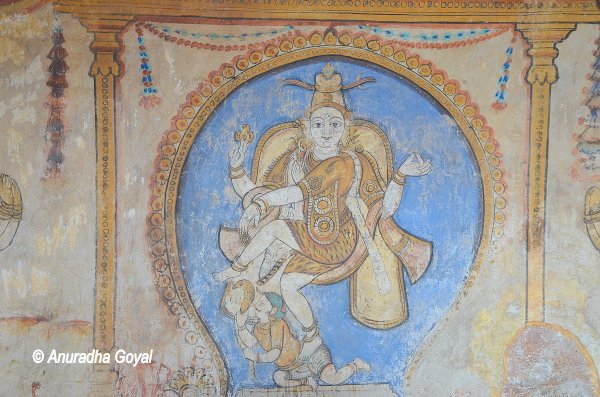
Paintings at Brihadeeswara Temple
The Pradakshina path of the inner sanctum sanctorum is supposed to have wall paintings from the times of Cholas. That was later superimposed by the paintings of Nayaka’s time. This part is also closed to visitors. You need to have special permission from ASI to be able to see the paintings. Thankfully the paintings have been reproduced in the Interpretation center through special techniques. You can see the replicas of the paintings here. This part of Tanjore temple opens after 10:00 AM and not along with the temple in the morning. The hall that houses the paintings is a covered part of the corridor on the periphery of the temple. And is completely dark. So in case, there is no power at the time when you visit, you would not be able to see much.
More Paintings on the walls of corridors
Another set of paintings is on the walls of the corridors surrounding the temple and is worth a watch. Painted on the thick lime-plastered walls these paintings depict the stories associated with Shiva. Barricaded corridor houses Shiva Lingas in various sizes and stones in front of these painted walls. If you move in the clockwise direction, you would see the stories flowing through the walls. The chipped parts tell you the technique used as the thick layer of lime reveals itself. Bright colors do not give away the age of the paintings and sometimes give the impression of being recent.
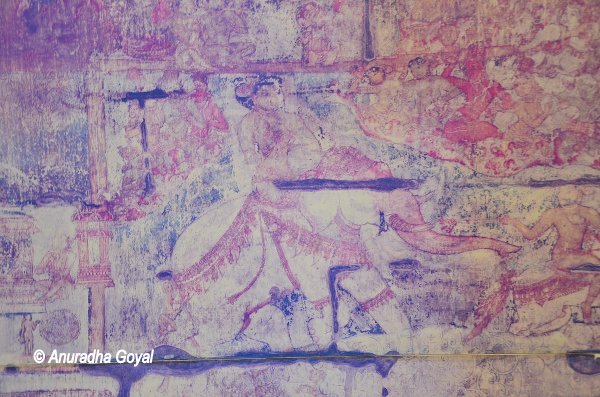
There are Sanskrit inscriptions on a wall in the temple. Around this wall, a small wall has been built to save a falling tree and provides support to the almost bent trunk. I could not figure out if there was a special significance associated with the tree. But the gesture indicates the reverence that the tree deserves. It makes you think about the deep relation between spirituality, nature, and compassion.

UNESCO World Heritage Site
This is a UNESCO World Heritage Site in the city of Thanjavur or Tanjore in the southern Indian state of Tamil Nadu. It is one of the three Great Living Chola Temples. Built by Raja Raja Chola in the 11th century AD, it is a tourist attraction in Tamil Nadu. It is a hallmark of the times of the Chola dynasty in architecture, painting, sculptures, and bronze casting.
Must-Visit Brihadeeswara Temple
If there are two temples you must see before you leave, go to Brihadeeswara temple in Tanjore and Kandariya Mahadeva temple in Khajuraho. Both these temples you must visit at least twice a day. Once, early in the morning as the first rays of sun illuminate the shimmering stones. And once later may be at noon or early evening. The stone changes color and creates an entirely different ambiance at different times of the day. The mix of visitors changes. And you get a feeling of visiting an entirely different place in a single day at the same place. If you go early enough on full moon days, you can get to see the Shikhara playing with the moon and it is a sight to see.
In addition, recommend you to read the following travel blog posts on the Chola trail in Tamil Nadu that you can undertake.
Srirangam Temple, Trichy – Largest Living Temple
Soaking the Charms of Airavatesvara Temple at Darasuram






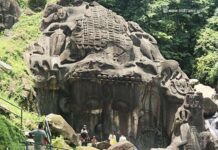
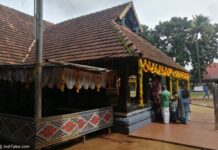
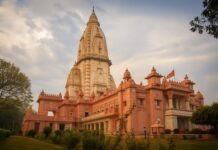





लगता है अबकी बार यहाँ भी जाना ही पड़ेगा।
This is definitely one of the best temples in the world. Nice write up.
Beautiful photographs, very nice
Really you feel very happy after visiting this temple and every one will be very spiritual after worshiping lord shiva…
Karthikvelu, at this temple I was more mesmerized by the architecture – the sheer poetry in stone.
The “Nandi” Pavillion is actually a Rishab Pavillion. Nandhi is the head of Siva Ganas. He has the same form of Siva. Rishab is the vahana of Siva.
2. The Pavilion we see today was later day addition which actually blocks the sun rays entering the sanctum – as it did during Rajaraja days.
Ramesh ji – Rishabh means a bull, and Nandi is the name of Shiva’s bull. So Yes, the mandapa can be called Nandi Mandapa or the Rishabh Mandapa.